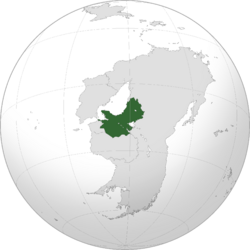Second Empire of Nadauro: Difference between revisions
Jump to navigation
Jump to search
mNo edit summary |
mNo edit summary |
||
| Line 48: | Line 48: | ||
|image_p1 = <!-- Use: [[File:Sin escudo.svg|20px|Image missing]] --> | |image_p1 = <!-- Use: [[File:Sin escudo.svg|20px|Image missing]] --> | ||
|s1 = Occupied Nadauro | |s1 = Occupied Nadauro | ||
|flag_s1 = | |flag_s1 = W Pennant for Nadauro.png | ||
|image_s1 = <!-- Use: [[File:Sin escudo.svg|20px|Image missing]] --> | |image_s1 = <!-- Use: [[File:Sin escudo.svg|20px|Image missing]] --> | ||
|s2 = Third Empire of Nadauro | |s2 = Third Empire of Nadauro | ||
| Line 78: | Line 78: | ||
|symbol_type = <!-- Displayed text for link under symbol. Default "Coat of arms" --> | |symbol_type = <!-- Displayed text for link under symbol. Default "Coat of arms" --> | ||
|symbol_type_article = <!-- Link target under symbol image. Default: Coat of arms of {{{common_name}}} --> | |symbol_type_article = <!-- Link target under symbol image. Default: Coat of arms of {{{common_name}}} --> | ||
|image_map = | |image_map = [[File:Nadauro_version_1_locator_global_map.png|250px]] | ||
|image_map_alt = | |image_map_alt = | ||
|image_map_caption = The Empire of Nadauro at its peak and largest territorial extent in 1938. | |image_map_caption = The Empire of Nadauro at its peak and largest territorial extent in 1938. | ||
| Line 140: | Line 140: | ||
|stat_area5 = | |stat_area5 = | ||
|stat_pop5 = | |stat_pop5 = | ||
|today = {{flag|Nadauro}} | |today = {{flag|Nadauro}} | ||
|footnote_a = <!-- Accepts wikilinks --> | |footnote_a = <!-- Accepts wikilinks --> | ||
|footnote_b = <!-- Accepts wikilinks --> | |footnote_b = <!-- Accepts wikilinks --> | ||
Revision as of 14:06, 31 May 2024
This article is incomplete because it is pending further input from participants, or it is a work-in-progress by one author. Please comment on this article's talk page to share your input, comments and questions. Note: To contribute to this article, you may need to seek help from the author(s) of this page. |
Empire of Nadauro Império do Anadaúro | |||||||||||
|---|---|---|---|---|---|---|---|---|---|---|---|
| 1885–1950 | |||||||||||
Flag (1885–1940)
| |||||||||||
| Motto: Força ou Morte "Strength or Death" | |||||||||||
| Anthem: O Reinado do Imperador "The Emperor's Reign" | |||||||||||
 The Empire of Nadauro at its peak and largest territorial extent in 1938. | |||||||||||
| Status |
| ||||||||||
| Capital | Forte de Agosto (1885–1894) Itabira (1894–1850) | ||||||||||
| Common languages | Lavish | ||||||||||
| Religion | Gregorianism | ||||||||||
| Demonym(s) | Nadauran | ||||||||||
| Government | Unitary constitutional monarchy (1885–1921)
| ||||||||||
| Emperor | |||||||||||
• 1885–1902 | Pedro I | ||||||||||
• 1902–1922 | Luís III | ||||||||||
• 1922–1927 | Pedro II | ||||||||||
• 1927–1950 | Agustín I | ||||||||||
| Prime Minister | |||||||||||
• 1885–1899 (first) | Emanuel Teixeira | ||||||||||
• 1921–1940 | Lúcio Cabral | ||||||||||
• 1947–1950 (last) | Maurício Álvarez dos Reis | ||||||||||
| Legislature | National Congress | ||||||||||
| Senate | |||||||||||
| Chamber of Representatives | |||||||||||
| Historical era | 1885–1950 | ||||||||||
• Beginning of the National Schism | 17 April 1885 | ||||||||||
| 4 February 1886 | |||||||||||
| 25 March 1886 | |||||||||||
| 10 July 1909 | |||||||||||
| 20 June 1921 | |||||||||||
| 2 May 1930 | |||||||||||
| 11 January 1934 | |||||||||||
| 8 August 1936 | |||||||||||
| 25 March 1940 | |||||||||||
| 10 August 1950 | |||||||||||
| Population | |||||||||||
• 1900 | 26,800,000 | ||||||||||
• 1930 | 44,570,000 | ||||||||||
| Currency | Nadauran coroa | ||||||||||
| |||||||||||
| Today part of | |||||||||||
The Second Empire of Nadauro (Lavish: Segundo Império de Anadaúro), officially the Empire of Nadauro (Lavish: Império de Anadaúro) and also referred to as imperial Nadauro or simply Nadauro, was the nation state and constitutional monarchy that comprised the territories of modern-day Nadauro and other Elia Australian countries from the beginning of the National Schism on 4 February 1886 until the enactment of the reformed Constitution of Nadauro on 10 August 1950.
TBD


